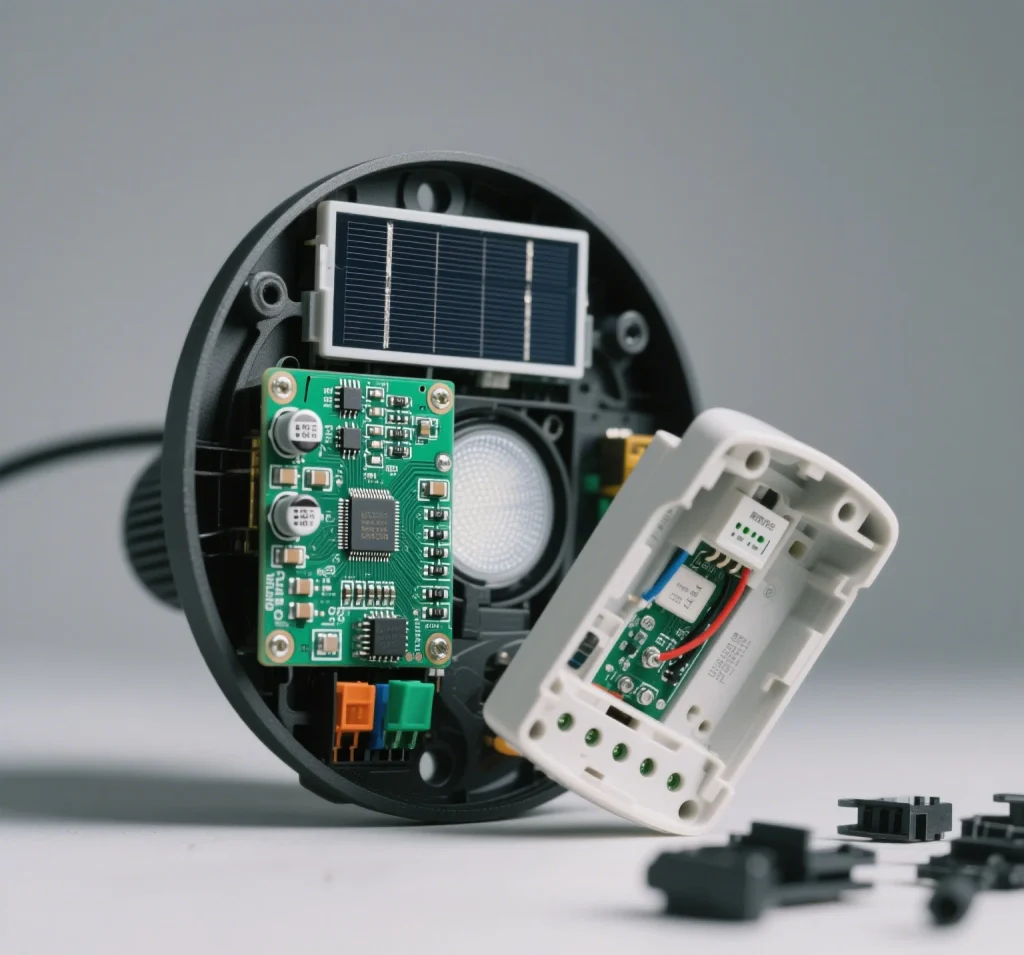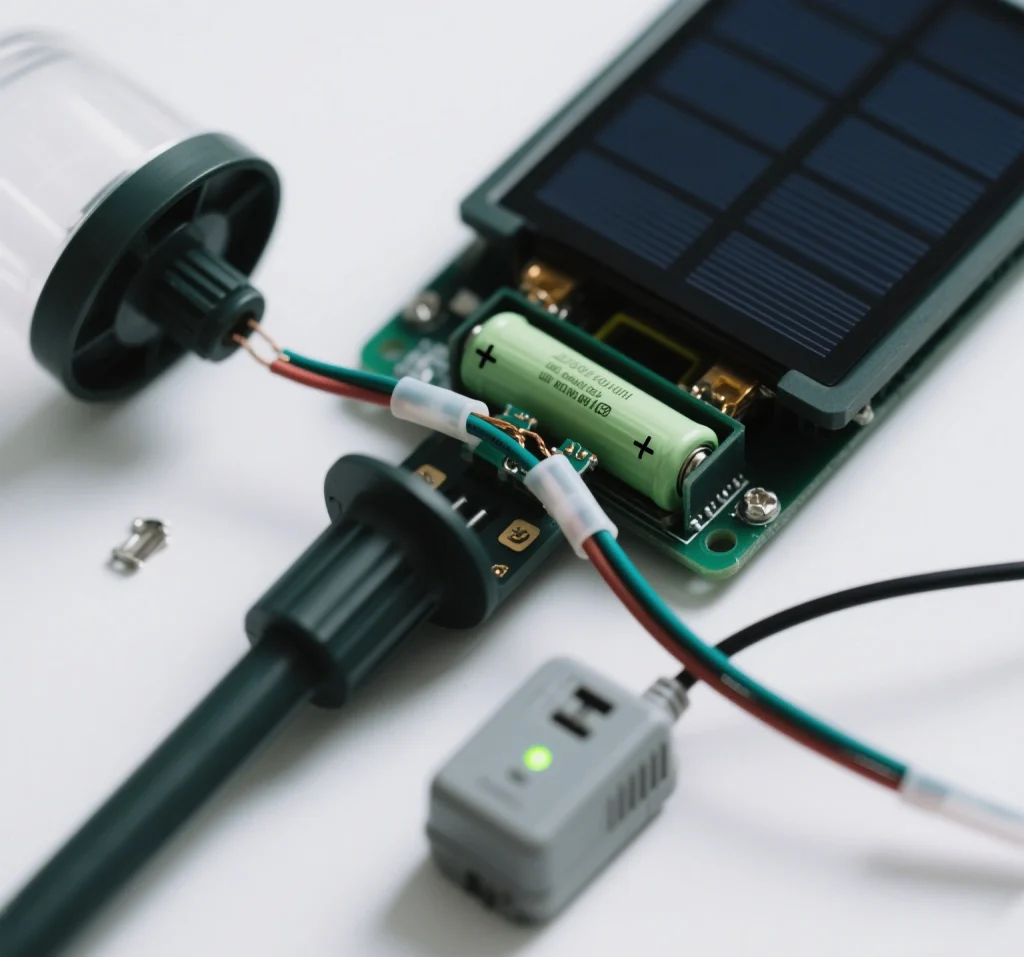Solar lights with PIR sensors are an excellent choice for outdoor lighting solutions, offering energy efficiency and hands-free operation. However, when the PIR sensor—the component responsible for detecting motion—malfunctions, it can disrupt the entire system. This detailed guide walks you through diagnosing and repairing common PIR sensor problems, using Bitpott’s high-quality solar-powered lighting as an example. Whether your light fails to turn on, flickers unpredictably, or doesn’t detect motion, these proven steps—checking the battery, cleaning key components, adjusting sensitivity, and inspecting wiring—will help you restore functionality. Designed for practicality, this article targets readers seeking reliable fixes for their eco-friendly lighting.

What Are PIR Sensor Solar Lights?
PIR (Passive Infrared) sensors work by detecting changes in infrared radiation, such as the heat emitted by moving objects like people or animals. In solar lights, this technology triggers the light to activate only when motion is detected, saving energy during idle periods. Bitpott’s solar outdoor lights combine efficient solar panels with advanced PIR sensors, making them a standout option for sustainable illumination. That said, issues like battery depletion, dirt buildup, or wiring faults can arise over time, especially in harsh outdoor conditions. Let’s dive into the troubleshooting process.
Step 1: Check and Replace the Battery
A dead or degraded battery is often the root cause of solar light malfunctions. Since these lights depend on rechargeable batteries powered by sunlight, ensuring battery health is the logical first step.
How to Diagnose
If your solar light won’t turn on, dims quickly, or behaves inconsistently, test the battery. Use a multimeter to measure its voltage—most solar lights require 1.2V to 3.7V, depending on the model. If the reading is significantly lower, the battery is likely failing.
Replacing the Battery
Swap out the old battery for a new, compatible one. Bitpott’s products often use durable lithium-ion batteries, known for their high capacity and lifespan. Check your light’s manual for the exact specifications (e.g., AA 1.2V NiMH or 3.7V 18650 lithium-ion). After replacement, charge the light in direct sunlight for 6-8 hours and test it again.
Pro Tip
Extreme temperatures can shorten battery life. For optimal performance, store or shield your solar-powered lighting during severe weather. Regular checks every 6-12 months can preempt issues.
Step 2: Clean the Sensor and Solar Panel
Dirt and debris can block the PIR sensor or reduce the solar panel’s ability to charge, leading to poor performance. Cleaning is a quick, cost-free fix that often resolves solar light malfunctions.
Cleaning the PIR Sensor
Wipe the sensor lens with a soft, dry cloth to remove dust or grime. Avoid harsh chemicals or abrasive tools that could scratch it, as a damaged lens impairs motion detection. A clean sensor ensures reliable triggering.
Cleaning the Solar Panel
Use a damp cloth to clear dirt, leaves, or bird droppings from the solar panel. Studies suggest that a clean panel can boost energy output by up to 20%, directly improving battery charging. For stubborn residue, mild soap and water work well—just dry it thoroughly afterward.
Maintenance Note
Bitpott’s solar panels feature anti-soiling surfaces, reducing buildup, but monthly cleaning is still wise, especially in dusty or rainy climates.
Step 3: Adjust Sensor Sensitivity
If your solar light activates too often or not at all, the sensor sensitivity might need tweaking. This setting controls how easily the PIR sensor detects motion, and finding the right balance is key.
Locate the Controls
Look for a sensitivity”

Fix Your PIR Sensor Solar Light with Bitpott’s Proven Methods
Solar lights with PIR sensors are an excellent choice for outdoor lighting solutions, offering energy efficiency and hands-free operation. However, when the PIR sensor—the component responsible for detecting motion—malfunctions, it can disrupt the entire system. This detailed guide walks you through diagnosing and repairing common PIR sensor problems, using Bitpott’s high-quality solar-powered lighting as an example. Whether your light fails to turn on, flickers unpredictably, or doesn’t detect motion, these proven steps—checking the battery, cleaning key components, adjusting sensitivity, and inspecting wiring—will help you restore functionality. Designed for practicality, this article targets readers seeking reliable fixes for their eco-friendly lighting.
What Are PIR Sensor Solar Lights?
PIR (Passive Infrared) sensors work by detecting changes in infrared radiation, such as the heat emitted by moving objects like people or animals. In solar lights, this technology triggers the light to activate only when motion is detected, saving energy during idle periods. Bitpott’s solar outdoor lights combine efficient solar panels with advanced PIR sensors, making them a standout option for sustainable illumination. That said, issues like battery depletion, dirt buildup, or wiring faults can arise over time, especially in harsh outdoor conditions. Let’s dive into the troubleshooting process.
Step 1: Check and Replace the Battery
A dead or degraded battery is often the root cause of solar light malfunctions. Since these lights depend on rechargeable batteries powered by sunlight, ensuring battery health is the logical first step.
How to Diagnose
If your solar light won’t turn on, dims quickly, or behaves inconsistently, test the battery. Use a multimeter to measure its voltage—most solar lights require 1.2V to 3.7V, depending on the model. If the reading is significantly lower, the battery is likely failing.
Replacing the Battery
Swap out the old battery for a new, compatible one. Bitpott’s products often use durable lithium-ion batteries, known for their high capacity and lifespan. Check your light’s manual for the exact specifications (e.g., AA 1.2V NiMH or 3.7V 18650 lithium-ion). After replacement, charge the light in direct sunlight for 6-8 hours and test it again.
Pro Tip
Extreme temperatures can shorten battery life. For optimal performance, store or shield your solar-powered lighting during severe weather. Regular checks every 6-12 months can preempt issues.
Step 2: Clean the Sensor and Solar Panel
Dirt and debris can block the PIR sensor or reduce the solar panel’s ability to charge, leading to poor performance. Cleaning is a quick, cost-free fix that often resolves solar light malfunctions.
Cleaning the PIR Sensor
Wipe the sensor lens with a soft, dry cloth to remove dust or grime. Avoid harsh chemicals or abrasive tools that could scratch it, as a damaged lens impairs motion detection. A clean sensor ensures reliable triggering.
Cleaning the Solar Panel
Use a damp cloth to clear dirt, leaves, or bird droppings from the solar panel. Studies suggest that a clean panel can boost energy output by up to 20%, directly improving battery charging. For stubborn residue, mild soap and water work well—just dry it thoroughly afterward.
Maintenance Note
Bitpott’s solar panels feature anti-soiling surfaces, reducing buildup, but monthly cleaning is still wise, especially in dusty or rainy climates.
Step 3: Adjust Sensor Sensitivity
If your solar light activates too often or not at all, the sensor sensitivity might need tweaking. This setting controls how easily the PIR sensor detects motion, and finding the right balance is key.
Locate the Controls
Look for a sensitivity dial or switch near the sensor—on Bitpott lights, it’s typically accessible on the housing. Some models also include range and duration settings, which you can adjust simultaneously.
Fine-Tuning
Set the sensitivity to medium, then test it by walking within its detection range (usually 10-20 feet). If it triggers too easily (e.g., from pets or wind), lower the setting. If it misses you entirely, increase it. Adjust incrementally until it performs as desired.
Environmental Factors
In rural areas with wildlife, lower sensitivity prevents false activations. In busy urban settings, higher sensitivity ensures the light catches every passerby. Seasonal changes, like increased wind in fall, might also call for adjustments.
Step 4: Check Wiring for Loose Connections
Faulty wiring can interrupt power flow, causing the PIR sensor or light to fail. This step requires a bit of hands-on effort but can solve persistent issues.
Inspection
Carefully open the light’s casing (unplug or switch it off first) and examine the internal wiring. Look for loose connections, frayed wires, or corrosion—common culprits in outdoor devices exposed to moisture.
Repairs
Reattach loose wires by twisting them back into place or using a small screwdriver to tighten terminals. For corroded or broken wires, replace the damaged section and seal it with electrical tape or heat-shrink tubing. Test the light after reassembly.
Durability Insight
Bitpott designs its wiring for resilience, but prolonged exposure to rain or humidity can still take a toll. If problems persist, the solar panel or sensor itself might need further testing.
Advanced Troubleshooting
If the basics don’t fix your PIR sensor problems, try these next-level checks:
Test the PIR Sensor
Cover the sensor with a dark cloth for 10-15 seconds. If the light turns on or off as expected, the sensor is likely fine. No response suggests a faulty sensor, which may require professional repair or replacement.
Measure Solar Panel Output
Use a multimeter to check the solar panel’s voltage in full sunlight. Compare it to the manufacturer’s specs (e.g., 5V or higher for many models). Low output could mean a defective panel or insufficient cleaning.
Reset the System
Some solar lights have a reset button or can be reset by disconnecting the battery for 30 seconds. This can clear electronic glitches affecting the PIR sensor.
Preventive Maintenance Tips
Keep your solar outdoor lights in top shape with these habits:
- Monthly Cleaning: Wipe the solar panel and PIR sensor to maintain efficiency.
- Battery Monitoring: Test voltage biannually and replace batteries showing wear.
- Seasonal Tweaks: Adjust sensor sensitivity for weather or activity changes.
- Weather Protection: Use covers or strategic placement to shield lights from storms.
Why Bitpott Stands Out
Bitpott’s solar lights shine thanks to their monocrystalline solar panels, precise PIR sensors, and IP67 waterproof ratings. These features ensure consistent performance, whether in scorching summers or freezing winters. While no light is immune to wear, Bitpott’s engineering paired with these repair methods keeps them reliable for years.
Conclusion
Fixing a PIR sensor solar light is straightforward with the right approach. By checking the battery, cleaning the sensor and panel, adjusting sensitivity, and securing wiring, you can tackle most solar light malfunctions. These steps, proven effective with Bitpott’s products, empower you to maintain your outdoor lighting solutions without breaking the bank. Armed with this guide, you’ll enjoy bright, motion-activated light whenever you need it—sustainably and hassle-free.


Leave a Reply